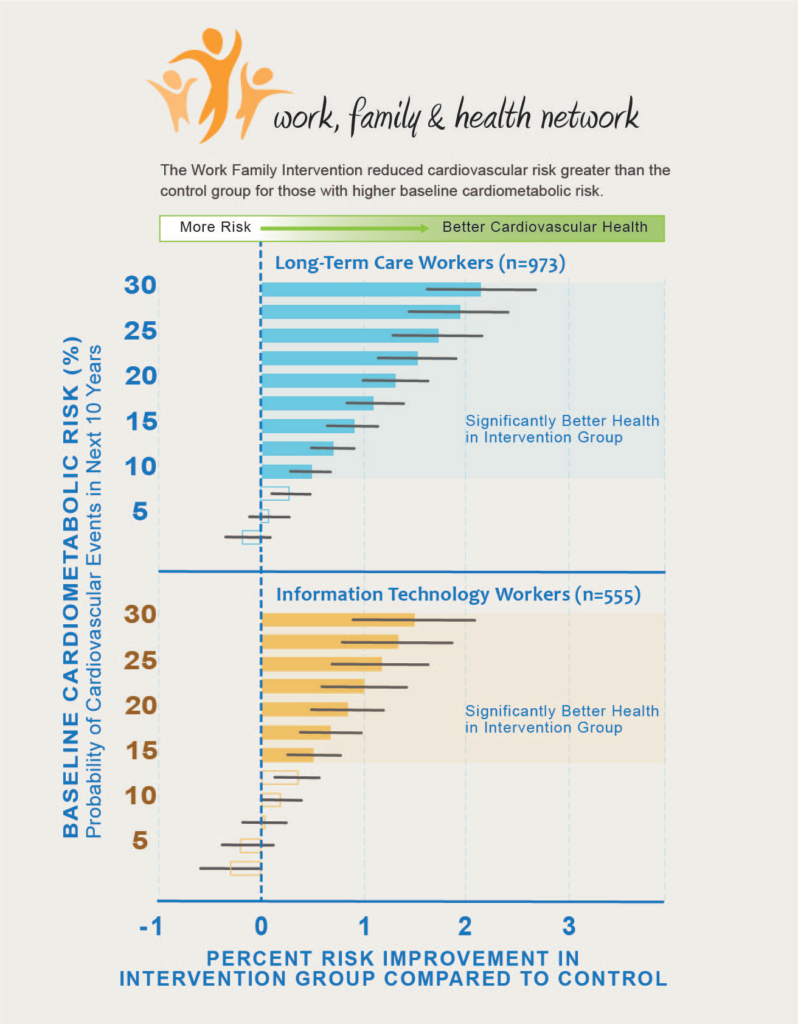Researchers observed reductions in cardiometabolic risk among employees at higher risk for cardiovascular disease whose workplaces provided them more control over their time and tasks
For immediate release: November 8, 2023
Boston, MA—Increasing workplace flexibility may lower certain employees’ risk of cardiovascular disease, according to a new study led by Harvard T.H. Chan School of Public Health and Penn State University. In workplaces that implemented interventions designed to reduce conflict between employees’ work and their personal/family lives, researchers observed that employees at higher baseline cardiometabolic risk, particularly older employees, experienced a reduction in their risk for cardiovascular disease equivalent to between five and 10 years of age-related cardiometabolic changes.
The study was published on November 8 in The American Journal of Public Health. It is among the first studies to assess whether changes to the work environment can affect cardiometabolic risk.
“The study illustrates how working conditions are important social determinants of health,” said co-lead author Lisa Berkman, Thomas D. Cabot Professor of Public Policy and of Epidemiology at Harvard Chan School and director of the Harvard Center for Population and Development Studies. “When stressful workplace conditions and work-family conflict were mitigated, we saw a reduction in the risk of cardiovascular disease among more vulnerable employees, without any negative impact on their productivity. These findings could be particularly consequential for low- and middle-wage workers who traditionally have less control over their schedules and job demands and are subject to greater health inequities.”
As part of the Work, Family and Health Network, the researchers designed a workplace intervention meant to increase work-life balance: Supervisors were trained on strategies to show support for employees’ personal and family lives alongside their job performances, and teams (supervisors and employees) attended hands-on trainings to identify new ways to increase employees’ control over their schedules and tasks.
The researchers randomly assigned the intervention to work units/sites within two companies: an IT company, comprised of 555 participating employees, and a long-term care company, with 973 participating employees. The IT employees consisted of male and female high and moderate-salaried technical workers; the long-term care employees mostly consisted of female, low-wage direct caregivers. Other units/sites were not assigned the intervention and therefore conducted their business as usual.
These 1,528 employees across the experimental and control groups had their systolic blood pressure, body mass index, glycated hemoglobin, smoking status, HDL cholesterol, and total cholesterol recorded at the beginning of the study and again 12 months later. The researchers used this health information to calculate a cardiometabolic risk score (CRS) for each employee, with a higher score indicating a higher estimated risk of developing cardiovascular disease within the decade.

The study found that the workplace intervention did not have any significant overall effects on employees’ CRS. However, the researchers did observe reductions in CRS specifically among those with a higher baseline CRS: Those employees of the IT company and of the long-term care company saw a reduction in their CRS equivalent to 5.5 and 10.3 years of age-related changes, respectively. Age also played a role: Employees older than 45 with a higher baseline CRS were likelier to see a reduction than their younger counterparts.
“The intervention was designed to change the culture of the workplace over time with the intention of reducing conflict between employees’ work and personal lives and ultimately improving their health,” said co-lead author Orfeu Buxton, professor of biobehavioral health and director of the Sleep, Health & Society Collaboratory at Penn State. “Now we know such changes can improve employee health and should be more broadly implemented.”
Hayami Koga, postdoctoral fellow at the Harvard Center for Population and Development Studies, was also a co-author.
Funding for the study came from the National Institutes of Health (grants U01HD051217, U01HD051218, U01HD051256, U01HD051276, R01HL107240, and U01AG027669) and the Centers for Disease Control and Prevention (grants U01OH008788 and U01HD059773). Additional funding came from the University of Minnesota’s College of Liberal Arts, McKnight Foundation, William T. Grant Foundation, Alfred P. Sloan Foundation, and the Administration for Children and Families.
“Employee Cardiometabolic Risk Following a Cluster-Randomized Workplace Intervention From the Work, Family and Health Network,” Lisa F. Berkman, Erin L. Kelly, Leslie B. Hammer, Frank Mierzwa, Todd Bodner, Tay McNamara, Hayami K. Koga, Soomi Lee, Miguel Marino, Laura C. Klein, Thomas W. McDade, Ginger Hanson, Phylis Moen, Orfeu M. Buxton, The American Journal of Public Health, November 8, 2023, doi: 10.2105/AJPH.2023.307413
Visit the Harvard Chan School website for the latest news, press releases, and multimedia offerings.
Image: iStock/Nuthawut Somsuk
For more information:
Maya Brownstein
mbrownstein@hsph.harvard.edu
Sara LaJeunesse
sdl13@psu.edu
###
Harvard T.H. Chan School of Public Health brings together dedicated experts from many disciplines to educate new generations of global health leaders and produce powerful ideas that improve the lives and health of people everywhere. As a community of leading scientists, educators, and students, we work together to take innovative ideas from the laboratory to people’s lives—not only making scientific breakthroughs, but also working to change individual behaviors, public policies, and health care practices. Each year, more than 400 faculty members at Harvard Chan School teach 1,000-plus full-time students from around the world and train thousands more through online and executive education courses. Founded in 1913 as the Harvard-MIT School of Health Officers, the School is recognized as America’s oldest professional training program in public health.
